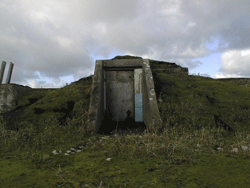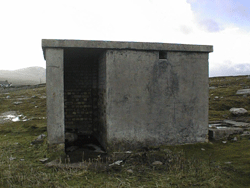Leirinbeg Sango Radar Station
During the Second World War the area at Lerinbeg and Sango was used for top secret training activities. A number of buildings exist from military use in the 1940’s and 50’s, Churchend, Lerinbeg and Smoo.
Durness was an important link in the coastal radar defences and later for early warning of a nuclear attack. A worker camp at Smoo and an RAF camp at Sango were built. Smoo lodge was used as an officers mess and the now youth hostel was service men accommodation.
The developments around the area were the direct result of the advance in wartime technology and the realisation by the government that radar was to play a vital role in the defence of the realm. Durness had been selected to cover an area from the Butt of Lewis to the Orkneys. With the end of the war in 1945, the influx of military personnel disappeared. During the next ten years, many of the buildings were dismantled but crofters made use of wartime buildings as hay stores and tractor sheds. The ruins of some and the improvement to others can be seen to this day.
This area of Lerinbeg Headland Lerinbeg, which means; the small half of a point, became the home of what was in 1940 a highly secret and technologically advanced military establishment. In the first year of the Second World War the inhabitants of the area had no access to certain localities for over 15 years. It was called RAF Sango and was a radar station.
The story of the radio war the success of which proved vital to the RAF Mastery in The Battle of Britain and subsequent operations involving fighter bomber commands is not widely known. This radar station was an installation part of a chain of new radar sessions around the coast of Great Britain referred to as Air ministry experimental stations. Along with defence of the country in detecting any incoming air raids they were to guide the British air crews home. Although now derelict with only ruins after demolition in 1957 older local inhabitants recall the influx of military and the influences and changes that took place in what was then a very remote and difficult to access community.

WARTIME IN DURNESS
At the outbreak of war in 1939, Durness had no mains electricity, no adequate mains water or sewage. There was only a small number of wireless sets and people relied on the daily newspaper delivery at about five p.m. to keep abreast with developments in the `outside world`.
Christie Macpherson and Miss Elliot ran a canteen for the RAF from the Durine church, open during the afternoon and early evening.
Towards the end of 1939, Air Ministry officials and surveyors arrived in Durness and land at Sangomore, Lerinbeg and Smoo was requisitioned. A worker's camp was built at Smoo and the construction of an RAF camp at Sango. These developments were the direct result of the advance in wartime technology and the realisation by the government that radar was to play a vital role in the defence of the realm. Durness had been selected to cover a belt from the Butt of Lewis to the Orkneys.
People of the district were now aware the war was on their doorstep. Wick had been bombed and a number of merchant ships had been sunk off Cape Wrath causing bodies to be washed ashore. A considerable number of local men had been called for National Service. Work continued on the construction, at Lerinbeg, a number of masts some one hundred and ten metres high appeared, underground communications centres and accommodation with storage units were built. By the end of 1940, about four hundred RAF personnel were in camp at Churchend Sango. They were for the most part radio operators and technicians. They had their own military transport and their garage still stands close to the front of the church at Sangomore. Used today by Iris and Donny Mackay for servicing the minibuses for travelling to Cape Wrath in the summer. A cookhouse, which the ruins of still stand, a dispensary, eight dormitory blocks, four of which have been converted into accommodation and are used today, rations supply store and a recreation centre were built. This was open to the locals and one of the biggest booms to the local people was the showing of films three or four times weekly. The work of the RAF was top secret and it was a long time before it was known Durness was the hub of a radar installation.
The army moved into Smoo Lodge as the headquarters. The adjacent office blocks, now the youth hostel, were erected in 1941. Soldiers were engaged in commando training in the valleys and hills around the village. Loch Eriboll was used as a safe haven for Royal Navy vessels to shelter and occasionally crews would come ashore at Laid and many a time RAF transport would be used to convey crews to a dance in Durness. To balance numbers, WAAF's were transported in from camps in Caithness. The men too old to go to war joined the Home Guard. They were charged with patrolling the village and the coastline to keep a look out for enemy landings and U Boats which used the bays and inlets around the coast to surface and re-charge batteries. Camouflage buildings at Lerinbeg were used as shelter when planes crossed overhead.
The sea areas from Cape Wrath to the Pentland Firth and the naval anchorage at Scapa Flo were extremely busy traffic lanes. Many German U-boats were around, constantly harassing shipping in this area and had sunk a number of ships. The Home Guard received regular training every week from the army personnel stationed in Durness. They were given uniforms rifles and live ammunition. As well as night time duties, they played a large part in military exercises receiving no payment. They patrolled in pairs at night after a day's work on the croft covering the whole village and the surrounding area.
There was constant rumour of the presence of German spies. There is no secure local knowledge of any spies ever being apprehended. Evidence does suggest a presence in the Cape Wrath area. Radio transmitters of German origin were found in a remote part and handed over to military authorities. The popular belief at the time was German agents had been landed by submarine or parachuted in, their object to transmit their findings to U boats in the vicinity. Another factor to support the spy scare is that there were reports from shepherds of occasionally observing strangers who quickly made themselves scarce. Articles of clothing and remnants of food were found at various locations. It was believed locally that German spies worked the area for short periods of time.
Even in this parish when there was no mains electricity the blackout was strictly adhered to. The military installations had an electrical supply. The majority of houses were lit with Tilley lamps or Aladdin oil lamps and were subject to black out regulations. Wooden shutters and thick curtain material were required. The police constables nightly duty was to enforce the regulations by patrolling the village in order to ensure no light could be seen.











Food rationing had an effect but it was not a critical factor in Durness. People were moderately self-sufficient. There was always plenty milk, butter and cowdrie, a kind of cheese, eggs, fish, mutton and home baking. Sugar, jam, sweets, tea, coffee, petrol, cigarettes and whisky were officially rationed. Enterprising locals carried on a profitable and mutually agreeable trading scheme with military personnel. Clothing, footwear, and household items were usually only available with coupons. There were two general merchant shops and a visiting butchers van from Dornoch and a grocer from Lairg once a week.
There were a few problems for drinkers in those times. The only licensed bar was the small public bar of the Cape Wrath Hotel and with the influx of construction workers and service personnel, could not cope. The RAF did have a licensed canteen at Sango. There was an acute shortage of whisky and a scarcity of glasses. Glass being required for the war effort. Being resourceful patrons took their own receptacle, usually a jam jar.
Domestic and social life continued. Many local men were away on national service and others were engaged on war work. The crofting continued. A common practice was people congregating in the house that had a radio to listen to the news and latest on the war fronts. The school continued with windows taped up and children carrying gas masks. The social life in the village was very active during the mid war period. There were weekly dances alternately in the village hall and RAF camp. Four films were shown every week, weekly whist drives, concerts and shows. In the summer football matches were arranged between locals and services, attracting teams from along the north. Most service members in Durness became part of the community. A New Zealand airman introduced Boy Scouts to Durness during the war but this organisation ceased after the departure of the soldier. There were numerous wartime romances in the village some of them extended to marriage. The servicemen either fell totally for the area and loved the life or hated it. Most accepted they were at the back of beyond and got used to it. Some rebelled and deliberately caused their arrest to be sent for service punishment, usually drafted overseas.
For the first time, there was full employment. Ministry contracts for construction and continuing projects brought people from the villages around to Durness for well paid work. With the end of the war in 1945, the influx of military disappeared leaving behind landmarks, buildings and pylons, of their stay. During the next ten years, many of the buildings were dismantled but crofters made use of wartime buildings as hay stores and tractor sheds. The relics of some and the improvement to others can be seen to this day.
To the local population war seemed to end as quickly as it started. Local men returned to victory celebrations. Collections were made and ex-servicemen treated to functions of dinner and dances in the village hall. A few did not return having paid the supreme sacrifice. The war memorial in the cemetery remembers these men. The Durness minister The Reverend John MacDougal chaplain with the Seaforth Highlanders, was killed in France in 1944. A plaque hangs in the Sangomore church in rememberance.
Durness also inherited electricity, mains sewage system and links with service personnel who often return to their wartime haunts. An article in the March 21st. 1998 issue of the Northern Times recall memories of RAF personnel stranded in a blizzard in 1945. The Village Hall fund and the youth Club have benefited from donations from people stationed here during the War.


